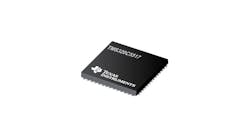Ultra-Low-Power DSP Delivers 200 MHz To Audio/Video Analytics
Featuring up to 200-MHz performance, Texas Instruments’ TMS320C5517 digital signal processor (DSP) speeds processing of data with low standby and low active power consumption, thanks to increased parallelism. Its core includes 13.33- to 5-ns instruction cycle time, a 75- to 200-MHz clock rate, dual multiply-and-accumulate units (up to 450 million multiply-accumulates per second, MMACS), two ALUs, and three internal data/operand read buses plus two write buses. It features 320 kbytes of zero-wait-state RAM, 64 kbytes of dual-access RAM (DARAM), 256 kbytes of single-access RAM (SARAM), and 128 kbytes of zero-wait-state ROM. Among the peripherals are a universal host-port interface (UHPI) with 16-bit multiplexed address or data bus, master and slave multichannel serial ports interface (McSPI) with three Chip Selects, a master and slave multichannel buffered serial ports interface (McBSP), and 16- and 8-bit external memory interface (EMIF) with glueless interface to NAND and NOR flash, SRAM, and SDRAM/mSDRAM. Also included are eMMC, MMC, and SD interfaces; an SPI with four Chip Selects; an I2C bus; three I2S bus modules; and up to 26 GPIO pins. Applications include audio/video processing, biometrics, and other analytic-specific apps.
